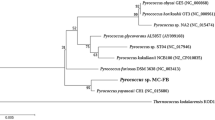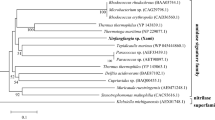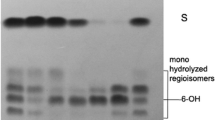Abstract
An amidase (EC 3.5.1.4) in branch 2 of the nitrilase superfamily, from the thermophilic strain Geobacillus pallidus RAPc8, was produced at high expression levels (20 U/mg) in small-scale fermentations of Escherichia coli. The enzyme was purified to 90% homogeneity with specific activity of 1,800 U/mg in just two steps, namely, heat-treatment and gel permeation chromatography. Sodium dodecyl sulfate-polyacrylamide gel electrophoresis (SDS-PAGE) and electron microscopic (EM) analysis of the homogenous enzyme showed the native enzyme to be a homohexamer of 38 kDa subunits. Analysis of the biochemical properties of the amidase showed that the optimal temperature and pH for activity were 50 and 7.0°C, respectively. The amidase exhibited high thermal stability at 50 and 60°C, with half-lives greater than 5 h at both temperatures. At 70 and 80°C, the half-life values were 43 and 10 min, respectively. The amidase catalyzed the hydrolysis of low molecular weight aliphatic amides, with d-selectivity towards lactamide. Inhibition studies showed activation/inhibition data consistent with the presence of a catalytically active thiol group. Acyl transfer reactions were demonstrated with acetamide, propionamide, isobutyramide, and acrylamide as substrates and hydroxylamine as the acyl acceptor; the highest reaction rate being with isobutyramide. Immobilization by entrapment in polyacrylamide gels, covalent binding on Eupergit C beads at 4°C and on Amberlite-XAD57 resulted in low protein binding and low activity, but immobilization on Eupergit C beads at 25°C with cross-linking resulted in high protein binding yield and high immobilized specific activity (80% of non-immobilized activity). Characterization of Eupergit C-immobilized preparations showed that the optimum reaction temperature was unchanged, the pH range was somewhat broadened, and stability was enhanced giving half-lives of 52 min at 70°C and 30 min at 80°C. The amidase has potential for application under high temperature conditions as a biocatalyst for d-selective amide hydrolysis producing enantiomerically pure carboxylic acids and for production of novel amides by acyl transfer.





Similar content being viewed by others
References
Agarkar VB, Kimani SW, Cowan DA, Sayed MF-R, Sewell BT (2006) The quaternary structure of the amidase from Geobacillus pallidus RAPc8 is revealed by its crystal packing. Acta Crystallogr F62:1174–1178
Banerjee A, Sharma R, Banerjee UC (2002) The nitrile-degrading enzymes: current status and future prospects. Appl Microbiol Biotechnol 60:33–44
Brenner C (2002) Catalysis in the nitrilase superfamily. Curr Opin Struct Biol 12:775–782
Bretaudiere JP, Frank J (1986) Reconstitution of molecule images analysed by correspondence analysis: a tool for structural interpretation. J Microsc 1986:44
Cameron RA (2002) Nitrile degrading enzymes from extreme environments. PhD thesis, University College, London
Cameron RA, Sayed M, Cowan DA (2005) Molecular analysis of the nitrile catabolism operon of the thermophile Geoacillus pallidus RAPc8B. Biochim Biophys Acta 1725:35–46
Chebrou H, Bigey F, Arnaud A, Galzy P (1996) Study of the amidase signature group. Biochim Biophys Acta 1298:285–293
Clarke PH (1970) The aliphatic amidases of Pseudomonas aeruginosa. Adv Microb Physiol 4:179–222
Crowther RA, Henderson R, Smith JM (1996) MRC image processing programs. J Struct Biol 116:9–16
Farnaud S, Tata R, Sohi MK, Wan T, Brown PR, Sutton BJ (1999) Evidence that cysteine-166 is the active-site nucleophile of Pseudomonas aeruginosa amidase: crystallization and preliminary X-ray diffraction analysis of the enzyme. Biochem J 340:711–714
Fournand D, Arnaud A (2001) Aliphatic and enantioselective amidases: from hydrolysis to acyl transfer activity. J Appl Microbiol 91:381–393
Fournand D, Pirat J-L, Bigey F, Arnaud A, Galazy P (1997) Spectrophotometric assay of aliphatic monohydroxamic acids and α-, β-, and γ-aminohydroxamic acids in aqueous medium, Analy Chim 353:359–366
Fournand D, Bigey F, Aranaud A (1998) Acyl transfer activity of an amidase from Rhodoccus sp. R312: Formation of a wide range of hydroxamic acids. Appl Environ Microbiol 64:2844–2852
Frank J (2006) Three-dimensional electron microscopy of macromolecular assemblies: visualization of biological molecules in their native state. Oxford University Press, New York
Frank J, Radermacher M, Penczek P, Zhu J, Li Y, Ladjadj M, Leith A (1996) SPIDER and WEB: processing and visualization of images in 3D electron microscopy and related fields. J Struct Biol 116:190–199
Kobayashi M, Fujiwana Y, Goda M, Komeda H, Shimizu S (1997) Identification of active sites in amindase: evolutionary relationship between amide-bond and peptide bond-cleaving enzymes. Proc Natl Acad Sci USA 94:11986–11991
Kotlova EK, Chestukhina GG, Astaurova OB, Leonova TE, Yanenko AS, Debabov VG (1999) Isolation and primary characterization of an amidase from Rhodococcus rhodochrous M8. Biochemistry 64:384–389
Laemmli UK (1970) Cleavage of structural proteins during the assembly of the head of bacteriophage T4. Nature 227:680–685
Madhavan NK, Roopesh K, Chacko S, Pandey A (2005) Comperative study of amidase production by free and immobilised Escherichia coli cells. Appl Biochem Biotechnol 120:97–108
Mylerova V, Martinkova L (2003) Synthetic applications of nitrile-converting enzymes. Curr Org Chem 7:1–17
Nakai T, Hasegawa T, Yamashita E, Yamamoto M, Kumasaka T, Ueki T, Nanba H, Ikenaka Y, Takahashi S, Sato M et al (2000) Crystal stucture of N-carbamyl-D-amino acid amidohydrolase with a novel catalytic framework common to amidohydrolases. Structure 8:729–737
Pace HC, Brenner C (2001) The nitrilase superfamily: classification, structure and function. Gen Bio 2:1–9
Pace HC, Hodawadekar SC, Draganescu A, Huang J, Bieganowski P, Pekarsky Y, Croce CM, Brenner C (2000) Crystal structure of the worm NitFhit Rosetta stone protein reveals a Nit tetramer binding two Fhit dimers. Curr Biol 10:907–917
Pereira RA, Graham D, Rainey FA, Cowan DA (1998) A novel thermostable nitrile hydratase. Extremophiles 2:347–357
Toogood HS, Taylor IN, Brown RC, Taylor SJC, Mccageu R, Littlechild JA (2002) Immobilization of the thermostable l-aminoacylase from Thermococcus litoralis to generate a reusable industrial biocatalyst. Biocatal Biotrans 20:241–249
Torres-Bacete J, Arroyo M, Torres-Guzman R, de la Mata I, Castallon MP, Acebal C (2000) Covalent immobilization of penicillin acylase from Streptomyces lavendulae. Biotechnol Appl Biochem 32:173–177
Torres-Bacete J, Arroyo M, Torres-Guzman R, de la Mata I, Castillon MP, Acebal C (2001) Stabilization of penicillin V acylase from Streptomyces lavendulae by covalent immobilization. J Chem Technol Biotechnol 76:525–528
Weatherburn MW (1967) Phenol-hypochlorite reaction for determination of ammonia. Anal Chem 39:971–974
Author information
Authors and Affiliations
Corresponding author
Rights and permissions
About this article
Cite this article
Makhongela, H.S., Glowacka, A.E., Agarkar, V.B. et al. A novel thermostable nitrilase superfamily amidase from Geobacillus pallidus showing acyl transfer activity. Appl Microbiol Biotechnol 75, 801–811 (2007). https://doi.org/10.1007/s00253-007-0883-2
Received:
Revised:
Accepted:
Published:
Issue Date:
DOI: https://doi.org/10.1007/s00253-007-0883-2




